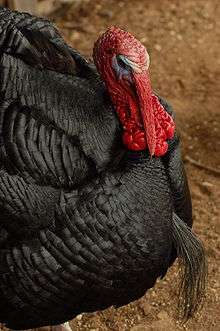Black turkey
The Black, sometimes referred to as the Black Spanish or the Norfolk Black, is a breed of domestic turkey. The Black was developed in Europe from the Aztec turkeys originally brought from Mexico by Spanish explorers.[1][2] Despite the monikers of “Spanish and “Norfolk” (England), birds of this type live in many European nations. Originally, black colored turkeys were a relative rarity among New World flocks, but Europeans heavily selected for this trait until it became predominant.[3] The "Norfolk Black" is generally considered the oldest turkey breed in the UK.
 A Black Spanish tom at the National Colonial Farm | |
| Other names | Black Spanish, Norfolk Black |
|---|---|
| Country of origin | Europe |
| Traits | |
| Skin color | black |
| Classification | |
| APA | Heritage breed |
| |
Black turkeys were sent in the holds of ships on the transatlantic crossing from Europe to the New World, and were raised by early colonists. It is possible that turkey consumed at the first Thanksgiving meal was taken from among European birds, rather than from among native wild turkeys, though both have common ancestors.[4]
Later, Blacks were crossed with the wild turkey to help produce breeds such as the Bronze, Narragansett, and Slate. They remained a commercially farmed variety in the U.S. until the early 20th century, but fell out of favor after the development of the Broad Breasted Bronze and Broad Breasted White. Fairly common in Europe, they are considered an endangered variety of heritage turkey today by the American Livestock Breeds Conservancy,[5] and are also included in Slow Food USA's Ark of Taste, a catalog of heritage foods in danger of extinction.[6]
A 1998 census conducted by the American Livestock Breeds Conservancy found that there were only 200 Black Spanish turkeys remaining in the United States, which were being raised by just 15 different breeders.[7] To help with conservation efforts, the Accokeek Foundation helped reintroduce this bird to the Potomac River tidewater region by sharing breeding stock with other historical museums and local farmers.[8] A rafter of Black Spanish turkeys is currently being preserved by the Heritage Breed Livestock Conservation Program within the National Colonial Farm at Piscataway Park to increase public awareness of this threatened breed.[9]
See also
Footnotes
- slowfoodusa.org
- news.discovery.com
- (Ekarius 2007, p. 227)
- (name & year)
- albc-usa.org
- slowfoodusa.org
- Burros, Marian (2001-11-21). "The Hunt for a Truly Grand Turkey, One That Nature Built". The New York Times. ISSN 0362-4331. Retrieved 2020-04-09.
- McKay, Kathryn (November 2005). "In Our Own Backyard: Talking Turkey". Washington Parent. Retrieved 9 April 2020.
- "National Colonial Farm: Heritage Breed Livestock Conservation". Accokeek Foundation at Piscataway Park. 2016. Retrieved 9 April 2020.
References
| Wikimedia Commons has media related to Norfolk Black. |
- Ekarius, Carol (2007). Storey's Illustrated Guide to Poultry Breeds. Storey Publishing. ISBN 978-1-58017-667-5.
- "Black Turkey". albc-usa.org. American Livestock Breeds Conservancy. Retrieved 2011-11-23.
- "Black Turkey". slowfoodusa.org. Slow Food USA. Retrieved 2008-09-21.
- "Native Americans First Tamed Turkeys 2,000 Years Ago". news.discovery.com. The Discovery Channel. Retrieved 2012-07-07.